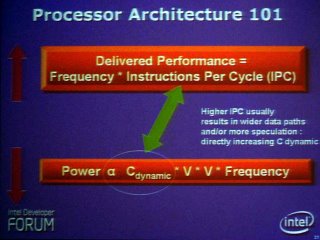Saturday, March 11, 2006
Conroe and Woodcrest problems
 HIGHER IPC of Core architecture consumes more power, not a less for useful computations!. But, due to enormous leakage it consumes even more when does nothing, and supply voltage is applied.
HIGHER IPC of Core architecture consumes more power, not a less for useful computations!. But, due to enormous leakage it consumes even more when does nothing, and supply voltage is applied.You can use lower clock (frequency) , but what will happen with delivered performance?
Yeah, the best kept IDF secret is broken. Lets make an thought experiment first.
Imagine that you are dual core processor like Conroe XE or Woodcrest. Well, hard to imagine
if you are not a split personality from the very beginning. But, just try. Now, think you run
at max of your performance ( that is after IDF event broadly advertised even in Timbuktu, then all speak about , and if all repeat it , that must be a truth, isn't it?). Then you should consume a max of power supply by voltage regulator module. Right? But what VRM specification? VRM 11, revision 1.1 is confirmed at IDF for you (Conroe or Woodcrest). OK, so what?.
I hope you feel both sides of your brain are sweating after heavy load. Benchmark indicator hits its max (at least 30% better than AMD64 max showed in endless IDF presentations) . Thus, our little thought experiment confiremd Intel's IDF claims? Finally!. Well, not quite. Do experiment above again, after say 10 seconds. Stupid! What for? All will be the same. No need!. But, are you quite sure?
If you are sure than look at VRM 11 spec revision 1.1 (or believe me on my honest word). VRM power supply will start to lose its steam -max current. Glance on amperemeter will not show 150A flowing into your brain, but say 145A. OK, so what? Well, lets suppose that the Law of Energy conservation is still valid (even for Intel's processor!, and any court in the US can't give other verdict about it).
That means less energy comes in your brain. OK so what? Well, less energy inflow due to previous, imposes less max processor performance, isn't it? I can't deny it. But which one processor? Both less equally, or one of them less and the second should run at the same performance max? But, which one processor will start too lose its performance. Honestly, I don't know, but perhaps you know? What will happen when more than two cores are on the chip ( say in 4+ cores I
 ntel's future star)? Fight for power!:
ntel's future star)? Fight for power!:Lets go back. Why VRM loses its steam?. Because 150A is its max current. It can't supply that current level indefinetely. VRM current output will start do diminish and you will find it in your second pass of thought experiment above. OK, and untill when its drop will continue? Until the steady current is reached , and for VRM 11 it is some 130A. Only after you see that value on VRM output amperemeter (or lower one), you will be shure that your benchmarks are really max. I would like to see Conroe XE 3,3Ghz amperemeter at that moment. Somehow, I am convinced that it will consume more than 130A at its peak moments.
But, Conroe consumes only 65W max in any case ! Hahaha. Be serious, please. At 3,3 ghz clock and 3 ALUs and improved FPU and 128bit SSE4 ,working simultaneously (and times 2 for dual core) consume only 65W?.
Let me conclude. To be sure on Intel's benchmarks look at their VRM current output during the benchmarking proicess. If benchamarks can be deliberately "tweaked" , amperemeter can't. VRM 11 max current output will drop from 150A to steady 130A in 100 seconds. And accordingly, its performance for some 20% too. ARE THOSE 20% IDF's improvement over AMD64 ones? Thus, any Conroe and Woodcrest max performance benchmark wouldn't last below 1000 seconds to be correct in 3% range . Otherwise, it shouldn't be called benchmarking, but cannon ball riding.
http://badhardware.blogspot.com/2006/03/intel-ceo-rides-again.html
This post link



